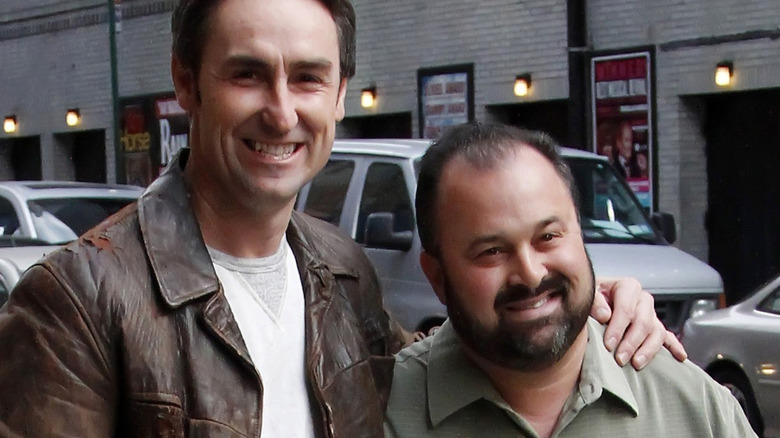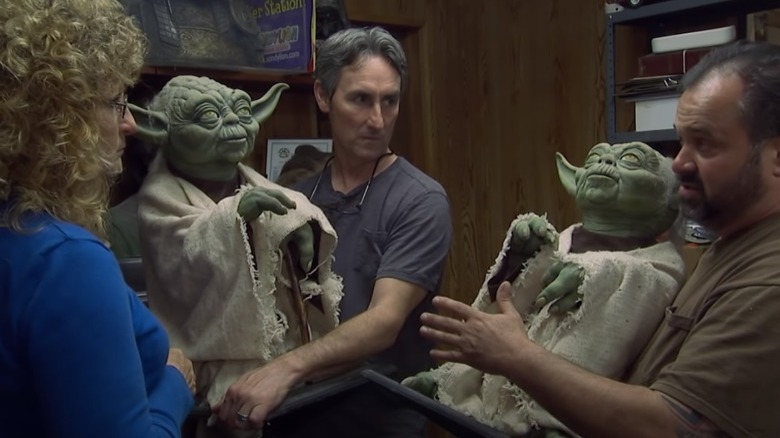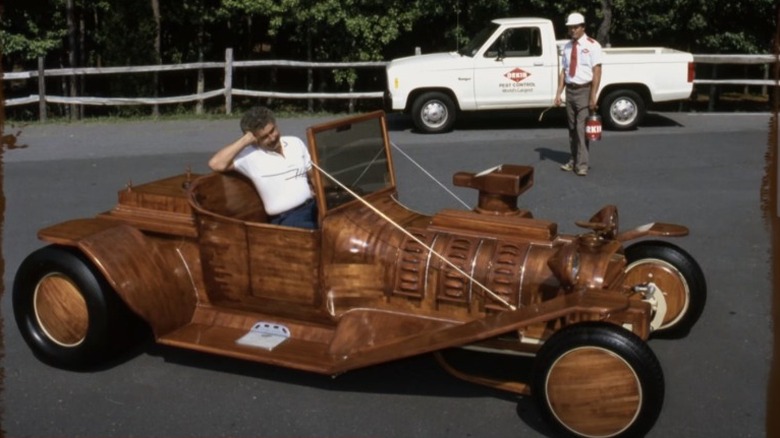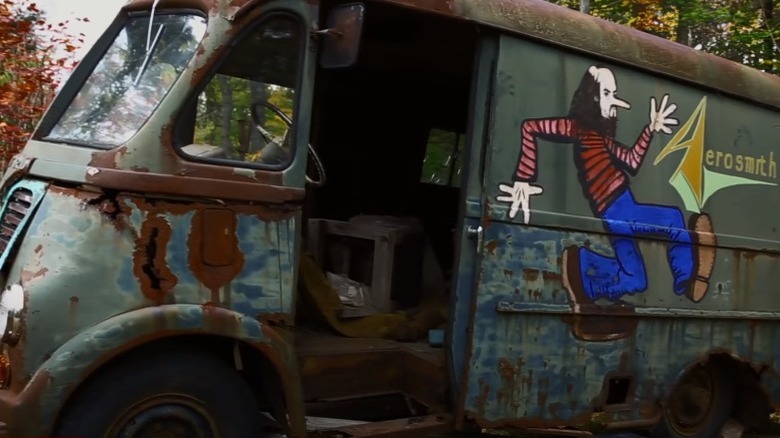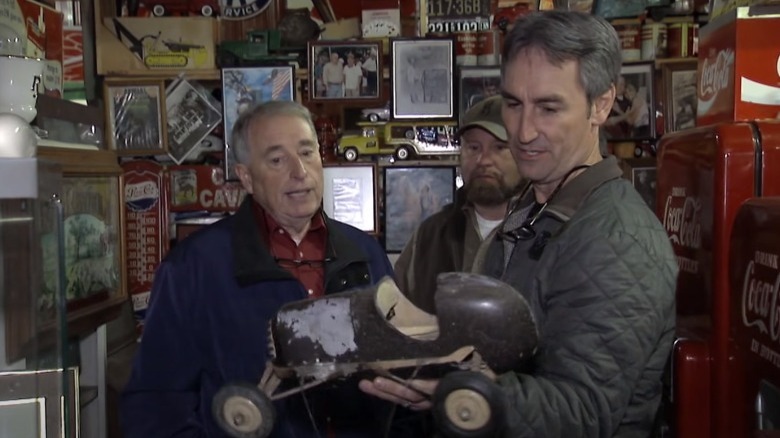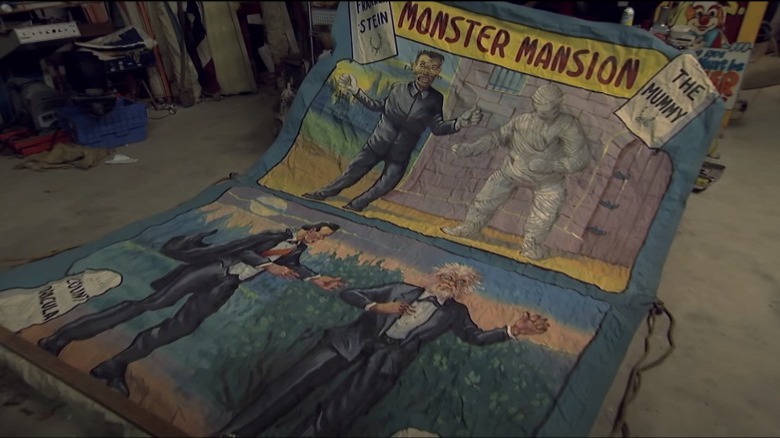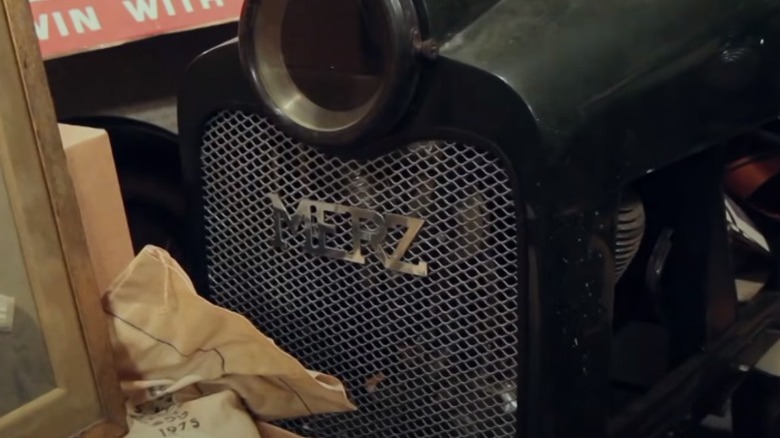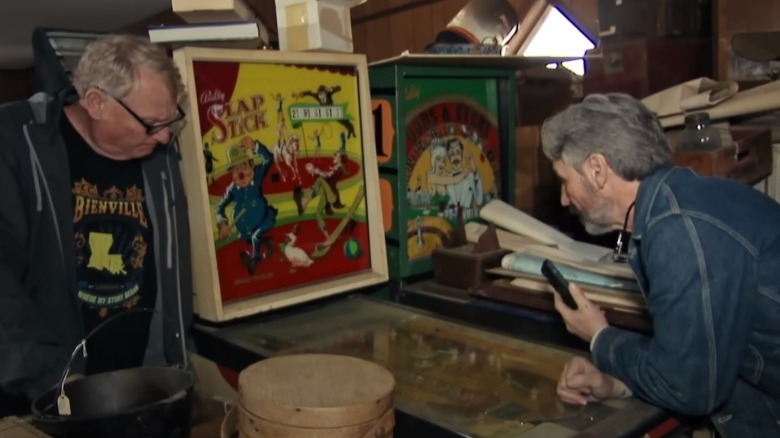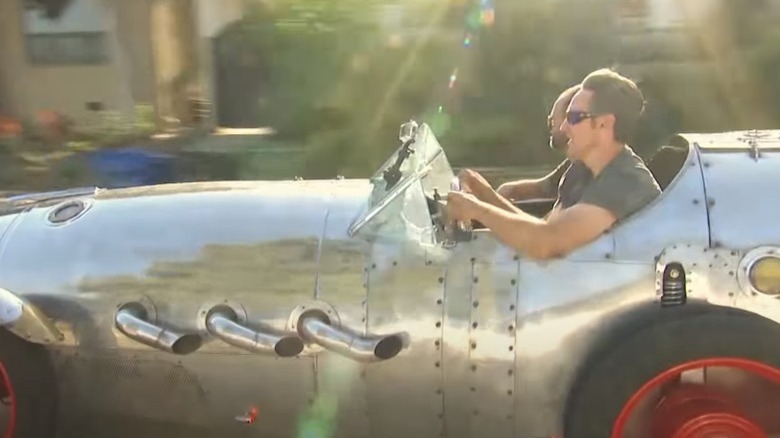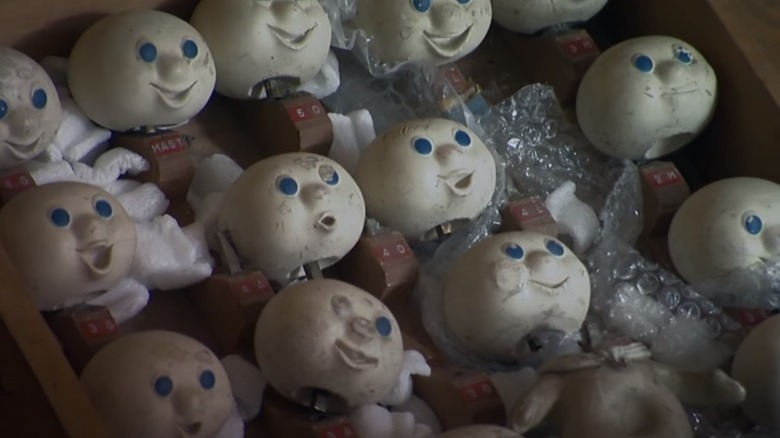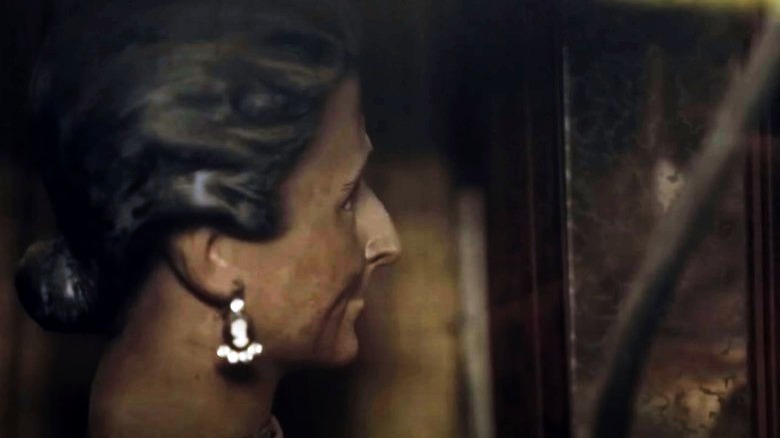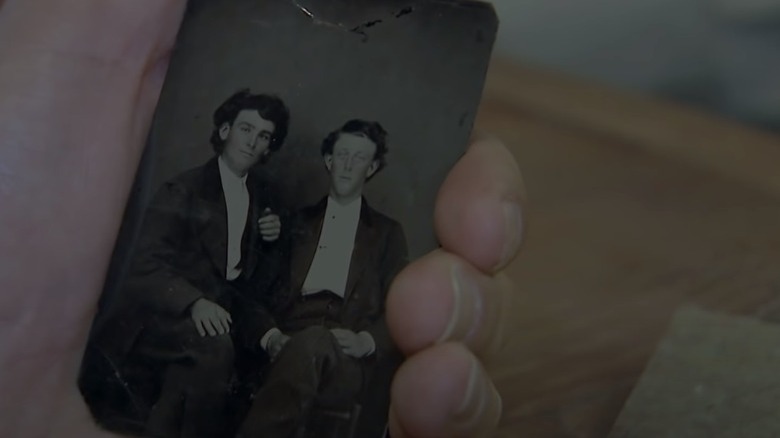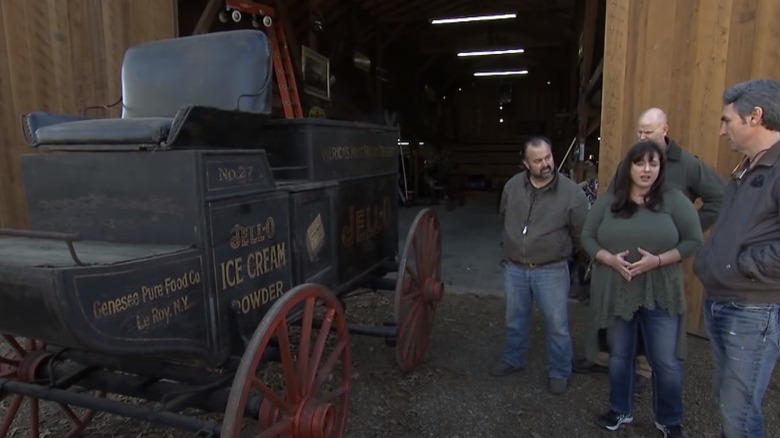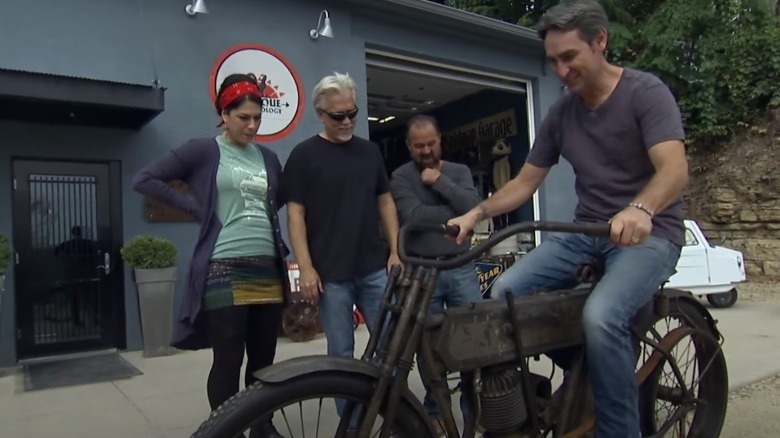The Best Finds On American Pickers
The American Pickers have been all over the country and discovered all kinds of treasures, and even though they haven't been without their controversy, they've kept people tuning in to see what's going to be uncovered from the next garage, barn, or home of the newest lifelong collector they've been put in touch with. But let's be honest — there are some finds that are way cooler than others.
Sure, old cars are fun (and oftentimes, they're way cooler than new ones), the signs are neat, and it was always fun to see Frank Fritz nerd out over a collection of vintage toys. But what about the really, really cool finds? The one-of-a-kind stuff, the stuff that even the most die-hard collector has never seen, the stuff that even Indiana Jones would say has to be in a museum? They've found plenty of those, too, and over the course of all the seasons and all the episodes, it's entirely possible that some of those finds have been long forgotten by even devoted viewers.
So, let's take a walk down memory lane, and just like the Pickers sorting through buildings with contents that haven't seen the light of day in quite a while, we'll sort through episodes to find the gems many may have forgotten about — but absolutely shouldn't.
Yoda prototypes
While there are still a few people who claim it's a point of pride that they haven't seen "Star Wars," even they have to know who iconic characters like Yoda and Darth Vader are: It's no secret that pop culture knowledge is absorbed by osmosis, and anyone who's turned on a television or glanced at social media just knows. Still, that said, the "Star Wars" find from Season 16 is one that true fans would appreciate most.
A phone call to sculptor, artist, and model-maker Mario Chiodo confirmed that they were looking at the real deal: Prototypes he had made of Yoda for the Jedi Master's introduction into the onscreen "Star Wars" universe. While there were a few models, there was only one that Chiodo could confirm he had actually made, thanks to a telltale glaze put on the model's eyes.
It was Frank Fritz who negotiated for the sale of that particular model, and for a cool $6,250, the pickers walked away with a little slice of movie history.
A handmade, wooden Model T
Some people are fortunate enough to find the one thing in life that they really love doing — and sometimes, they can spend hours fulfilling a lifelong dream. In a Season 17 episode called "Hot Rod Hero," Mike Wolfe and Frank Fritz took a tour of a massive property filled with unthinkably imaginative cars – including one so rare and so intricate that it stunned them speechless with the love and craftsmanship that had gone into building it, piece by piece.
That was the Wooden T, a Model T car built entirely from painstakingly handcrafted pieces of wood, all forming the body of a car built over a road-worthy frame and engine. From a hand-whittled hood ornament carved from black walnut to wooden windshield wipers and hubcaps, the project took an impressive seven years to complete, and once finished, was taken on the road to a number of car shows where it won against some stiff competition.
Wolfe and Fritz didn't even make an offer on the car — putting a price on it would have been impossible — but they did promise to try to help the owner get his father's creation into a museum, where it would be seen and appreciated by the public.
The Aerosmith van
It was during a Season 19 episode that Mike Wolfe and Frank Fritz met a guy named Phil. Phil had a property of a sort that looked pretty familiar to fans of the show, filled with old, once-magnificent items whose heyday had long since passed. There was something here that really stood out, though: An International Harvester Metro van with an oddly-shaped Aerosmith logo painted on the side.
The van's owner had rescued it out of the mud, but didn't know much more about it. He'd heard rumors that it might have been the first van Aerosmith used when they started playing together, but rumors and confirmation are two entirely different things — and while it might sound too good to be true, it was weird enough that the pickers decided to do some investigating of their own.
It's good to know people, and they were able to get Ray Tabano — original Aerosmith guitarist — to come out, take a look, and ultimately confirm that, yes, it was their old van. "It's been like 40 years since we've been in this thing," Tabano exclaimed. "I just flashed back, to when we first started the band. It was this amazing thing, all of a sudden here's this thing that we lived in. It was like our dressing room, it was like a rolling hotel." Tabano had something else cool, too — pictures of Aerosmith inside the van, showing details down to the rug still on the roof. And yes, they ended up buying it and getting it back to the band.
Tether car
When anyone starts talking about the good ol' days, there's any number of things they could mean. For many of a certain generation, it means a time before toys needed to be child-proofed. What kind of toys? Ones like the tether car that Mike Wolfe found in an episode of Season 17.
Tether cars, they say, were popular in the decades around World War II, and were essentially miniature racecars outfitted with internal combustion engines that propelled them around a circle track. They were attached and guided by a tether cable, and what kind of speeds were they talking? The record was set by a tether car clocked at 214 mph.
"This piece of metal, this missile, traveling that fast, in a circle, connected to a tether line, a cable... it's what every 10-year-old needs," Wolfe explained. The tether car they found was missing the engine, which was arguably the most important part. Still, the solid frame and original paint were still equal parts valuable and cool, especially considering how rare they're getting since the end of their heyday in the 1960s. Fortunately for Wolfe, they made a deal: After adding in a memory jar and some tether car frames, he took the whole lot home for $1,000.
Fred Johnson sideshow banners
The idea of olde-timey sideshows might look exploitative to modern eyes, but there's no denying it's a part of American history. Many traveling sideshows had their exhibits advertised with massive banners, and in Season 17, the American Pickers found a set of banners hand-painted by one of the most famous sideshow artists of the era, Fred Johnson.
Johnson, Wolfe explained, had worked for the O. Henry Tent & Awning Company for around four decades, starting in the 1930s. The banner that they had stumbled across — depicting all the classic movie monsters of the era, and promising only the bravest of visitors that they'd encounter them in the Monster Mansion — wasn't signed, but they still offered a not-too-shabby $3,500 for the piece.
At the same pick, they found some other cool banners, too — including one advertising an animatronic show depicting The Last Supper. It's not often viewers get to see Wolfe completely baffled, but he freely admitted that it was the first time he had seen a religious circus banner — although after talking out how it made sense to offer families with children something they could safely go see, without worrying about giving their kids nightmares, Wolfe offered $2,000 that the seller accepted.
Merz cycle car
So, what exactly is a cycle car? "American Pickers" explored exactly that when Frank Fritz came across an ultra-rare one. The cycle car dates back to a time when cars were relatively new, and extraordinarily expensive. With most people unable to afford a car, manufacturers got creative and came up with a more affordable hybrid cross between cars and motorcycles. There was still room for a passenger, and it could carry things like groceries and luggage, but ran on a more affordable motorcycle engine. At the time it sold, it was for a relatively reasonable $450, or — adjusted for inflation — about $12,600 as of late 2022 (via The Inflation Calculator).
The one they found dated to 1914, and even though it was restored and had some unoriginal parts, it was complete and rare enough that they agreed it needed to be in a museum.
It ended up being purchased by the Pickers and sold, and according to the National Motorcycle Museum, the car remains one of only two still around. Rare? Check. Old? Check. Cool? Check and check.
An ultra-rare pinball machine
Video games might be getting more advanced, more complicated, and more lifelike, but there's still something wonderfully nostalgic about the old-school games. From Atari to 8-bit consoles, they're still fun — and when it comes to hanging out with friends, pinball games were pretty much the pre-internet equivalent of today's online multiplayer games.
In a Season 23 episode, Mike Wolfe was climbing through a treasure trove of signs when he uncovered an ultra-rare pinball machine that he didn't recognize — and for good reason. The machine was one of just 85 made back around 1975, making the Bally Slap Stick machine one of the rarest pinball machines that any collector could try to get their hands on.
Exactly why the company designed and produced just 85 machines wasn't clear, but as Wolfe said, that's part of the allure. Imagining the life story of these rare video games is half the fun of owning them ... and perhaps more, as their expert suggested it just wasn't a very fun game to play, and the demand had fallen flat. Still, the gamers' loss was the collectors' win, and it was valued — in present rough condition, not working — as being worth around $3,000. An original offer of $1,500 was countered with $1,750, allowing them to make a deal that both parties were happy with.
A legit rocket car
In a lot of cases, original is better than restorations, especially if it was restored by someone who wasn't quite sure what they were doing. That rule didn't apply in one Season 12 episode, though, when Mike Wolfe and Frank Fritz met one of the most unique artists ever to be featured on the show.
The LA-based artist named Baron Margo collected and used scrap in his underground art pieces, and although he started by building small-scale model cars, he soon struck on the idea of building full-size cars ... so, he did. And given that they were based on smaller models, they ended up being equal parts imaginative, ingenious, and — best of all — were street legal, including the one with a jet engine mounted on the back.
That's the one that Fritz and Wolfe took out cruising, and there's a lot to be said for the expressions of pure joy on their faces as they sailed down the street, pulled up beside other cars, and asked for directions to In-and-Out Burger. The artist himself explained, "Mike and Frank went for a ride around the lake, just laughing all the way. That's what I try to do. If I can bring an emotion out of somebody, then I've succeeded at being an artist." The $50,000 price tag was a bit much — and, as Fritz pointed out, the insurance would be astronomical — so they didn't end up taking it home, but it was a bucket list kind of day.
Pillsbury Doughboy stop-motion models
In Season 23, Mike Wolfe headed out to pick the collection of Gene Warren, and while that might not be a household name, the movies he worked on certainly were. Before CGI, there was stop motion, and Warren headed up the stop motion effects on blockbusters including "Terminator 2." The family had scores of props that they had made for stop-motion movies, including the giant squid Wolfe recovered from outside beneath the trees: It was the monster from Peter Benchley's "The Beast."
It wasn't only the movies that were iconic, though, and among the stop-motion props Wolfe found a collection of models from one of the most well-known advertising campaigns in recent history: Pillsbury's Doughboy. They were a brilliant look behind the scenes, with Warren's sons — who had worked in the business as well — explaining that there were heads made with different facial expressions, so swapping them out could give the illusion of speech without needing to animate the mouths.
Also included were the hands, and a brilliant story about how Warren's sons also starred in the commercials — as the hands that poked the Doughboy's belly and made him giggle. The Doughboy heads were the embodiment of everything Wolfe looked for in a great piece: There was Americana, pop culture, nostalgia, advertising, art, and a story, all wrapped up in one pick. The Warren brothers' original $2,500 offer was countered, and for $2,250, Wolfe took them all home.
Fortune-telling Grandma
Tom Hanks wasn't always the serious, award-winning, unconditionally-beloved actor he is today — he started out as a goofball comedian. One of his most famous movies from that era of his career was "Big," where a teenaged version of himself makes a wish on a fortune-telling machine, and wakes up with an adult body. The American Pickers didn't find Zoltar, but in Season 17, they did find another one of the fortune-telling machines that were once so popular on boardwalks and in arcades across the country.
This one was called Gypsy Grandma, and she would open a cabinet to pull out a fortune for whoever crossed her palm with silver. Even though Mike Wolfe said he had seen people asking upwards of $10,000 for one, he stressed that he wouldn't be interested in paying that much. However, he was willing to take on the restoration work for this one.
For $1,400, he took Grandma home — along with contact information of restoration experts who could help get the coin-op treasure up and running again.
A photo of Billy the Kid
Authenticating rare photos of larger-than-life, olde-timey figures from the Wild West is admittedly hard, and in Season 13, Frank Fritz and Mike Wolfe came across something that had unlimited potential for being super cool — a new/old photo of Billy the Kid.
Purchased by the then-owner in 1979, the tintype was sourced from the daughter of Pat Garrett, the man who had shot and killed Billy the Kid in 1881. Forensics experts had been consulted, the owner explained, and were so certain that it was him that they claimed any jury would be happy to send a person away for life based on the quality of photographic evidence.
And as far as value? A previously sold image of Billy the Kid blew all auction estimates away and sold for a whopping $2.3 million. Needless to say, they were quick to say that it was way out of their price range, but agreed that researching items — and the potential to come across something of massive historical importance — like the photo was the fun part of collecting.
Vintage Jell-O wagon
It's often said that something is as American as apple pie, but the same could be said about Jell-O, too. In the U.S., it's the stuff of childhood desserts and questionable party platters from the 1970s, but it's still an undeniable favorite. It's that Americana that makes Mike Wolfe and Frank Fritz's Season 17 find of a vintage Jell-O wagon so cool.
The wagon would have been used to sell Jell-O from, and — still sporting the original paint, logos, and the name of the Genesee Pure Food Co. in LeRoy, NY — the pickers dated it to some time in the early 1900s. Although it was valued at between $8,000 and $10,000, Wolfe offered $6,500 and walked away with the find.
One of the only things that made Wolfe hesitate was the fact that it was going to take a very specific sort of collector to not only want to buy the wagon, but be able to store it. Fortunately, they found that buyer: The wagon ultimately ended up in Buffalo, NY's Pierce Arrow Museum, just a stone's throw from where it had originally been made in Rochester (via WKBW TV).
The final pieces to a 1911 Harley Davidson
No one gets into picking antiques without having a passion for it, and everyone has their thing. For Mike Wolfe, part of that was the dream of rebuilding a 1911 Harley Davidson motorcycle from pieces that they recovered from across the country, and in Season 11, he had finally found the last piece: the motor. He had spent more than four years looking for the 100-plus-year-old motor, and when he found it, it wasn't an easy buy.
Still, it was clearly an indescribably exciting find. Wolfe and partner Frank Fritz had spent so much time searching for the perfect pieces for clients that seeing them do something solely for themselves was a reminder of why they got into the business in the first place. "This thing is sweaty. It's scarred. It's rusted. I've been dreaming about it. Finally, we got the heartbeat for it," Wolfe explained.
And it was more than about just getting him a bike: They also lauded the entire community who had worked to not only bring all the pieces together, but then got the whole thing up and running again. Preserving such an intricate part of history was a group effort, and at the end of the day, that's what it's all about.
